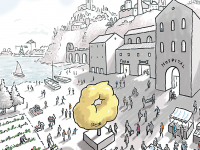
© J. Wagensberg
Some ideas are born and germinate in the mind but remain there, under contemplation, never making it out into the world to be tested. A few days ago, in a technology museum, I stood in front of an exhibit that is part of our collective memory, and that everyone has seen, either in true life or in photographs, a hundred times over. It was one of those first bikes, with a monumentally large front wheel and a tiny back wheel.
Puzzled, I wondered why I had never asked myself the question before: What accounts for a design so contrived and grotesque? What lies behind this crazy asymmetry?Often, when seeing something time and again, we confuse «understanding» with simple déjà vu. But no, it is not one and the same. It is not the same thing to see the moon hanging in the sky each night and to understand why it does not come crashing down to Earth. I went straight to the museum curator, who accompanied me, and –asking him– got ready to hear an eye-opening explanation from this expert. Alas, none was given. After briefly stammering, I was told the question did not have an exact answer: it was purely a question of aesthetics… Unacceptable! The answer could be any other response than one that supposed the taste fashionable in that epoch chose the most inconvenient option possible, or that in the olden days they liked to play at inventing anachronisms. The answer given in a brief impromptu conversation turned out to be true. The front wheel was the largest diameter possible so the bike could move forward as far as possible with each pedal stroke. The pedal was simply a rod joined to the centre of the wheel as the transmission, with a chain between gears of different sizes, had not been invented yet. The small diameter of the rear wheel was to minimize the weight of the bike. Having understood all this, I viewed it with new eyes and intellectual joy!
In a museum, an original exhibit is, in principle, a silent object, so the task of a museologist is specifically to make it talk, make it sing! There is much intellectual joy hidden in museum pieces and understanding comes when we find what is common between different things. That very day, during the same trip, my mind lit up –I do not know if I had read it somewhere or if I dreamed it up myself–. It concerns special moments in evolution: those in which radical innovation occurs. To be more precise, those moments that separate the end of one technological era from the beginning of a new one. As important as the technological leap may be, the aesthetics of the first artifact produced in the new era stays the same as the last of the previous era. To optimize and adapt forms takes longer than it seems. Finding one’s own language takes time.
One instance is that of the first motorcycle, which was a bicycle with an engine stuck on more or less awkwardly. The motorcycle then undertook a long journey to find its own language. It is difficult to make out the bike in a current motorcycle. Another example is the first motor car, which looked like a horseless carriage. So much so that you even think you can see the driver’s bench and the place to hook up the horses’ reins that will never be occupied. Since then, from today’s Formula One racing cars, to the elegant English automobiles or powerful Italian sedan, the car has not given up seeking its own language. None of these machines shows any trace of the original carriage. The first movie was filmed in a theatre. The first TVs were housed in huge wooden furniture around which families used to gather to listen to the radio, but now with a tiny screen. Typewriters are like dinosaurs they emerged, evolved, triumphed, dominated and then became extinct…
Museology began by locking itself inside glass cases, but has evolved to find its own language. This is natural selection of cultural selection.





